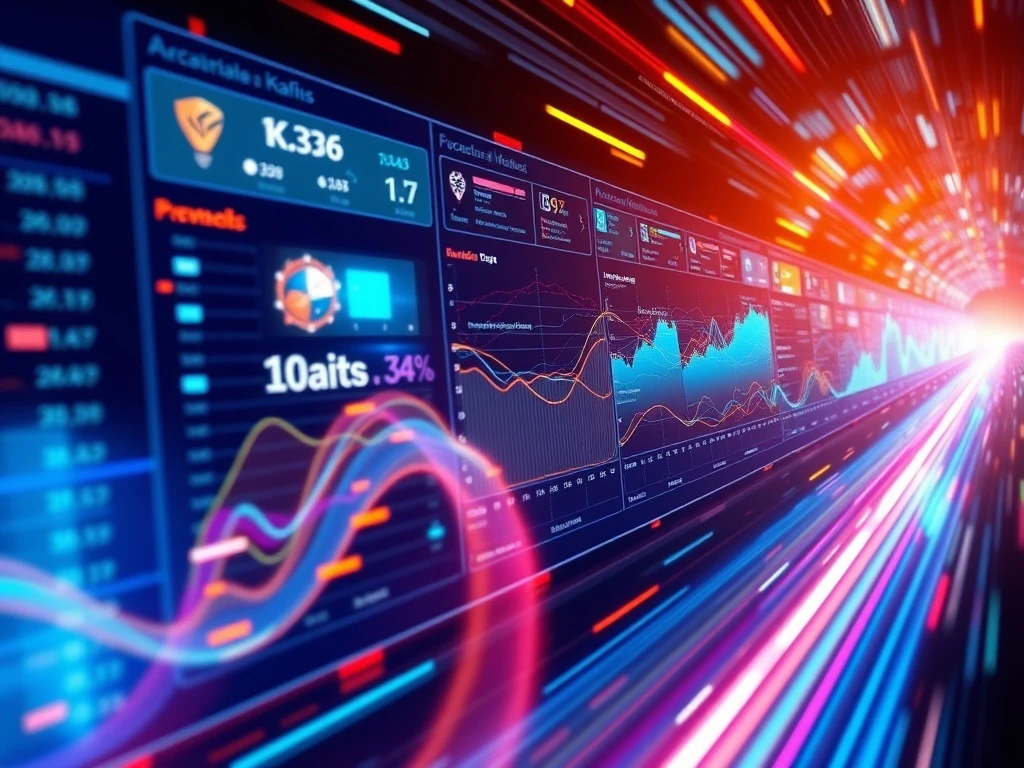In today’s fast-paced digital economy, businesses face an unprecedented deluge of data. Furthermore, the ability to process and act upon this information instantly provides a significant competitive edge. Therefore, **real-time analytics** has emerged as a critical capability, transforming raw data into immediate, actionable insights. This article explores how Apache Kafka and stream processing technologies empower organizations to achieve this vital agility, offering a profound impact on decision-making and operational efficiency for businesses and entrepreneurs alike.
What is Real-time Analytics?
Real-time analytics involves the processing of data as it arrives, providing immediate insights without significant delays. Consequently, it contrasts sharply with traditional batch processing, which analyzes data in large chunks after collection. Businesses leverage real-time analytics to understand current trends, monitor ongoing operations, and respond swiftly to events. For instance, this immediate understanding enables proactive measures and rapid adjustments.
Consider a retail business. Traditional methods might show sales figures from yesterday. However, with real-time analytics, they can see sales happening right now. They can identify popular items, observe inventory levels, and even detect unusual transaction patterns instantly. This immediate visibility is crucial. Moreover, it allows for dynamic pricing, personalized offers, and rapid fraud detection. Thus, real-time analytics provides a living, breathing view of business operations.
Key characteristics of effective **real-time analytics** systems include:
- **Immediacy:** Data processing occurs milliseconds after generation.
- **Continuity:** Data streams are processed continuously, not in discrete batches.
- **Actionability:** Insights are designed to trigger immediate responses or decisions.
- **Scalability:** The system must handle high volumes of incoming data efficiently.
Ultimately, the goal is to bridge the gap between data generation and insight generation, enabling organizations to operate with unparalleled responsiveness.
The Power of Apache Kafka in Real-time Analytics
Apache Kafka stands as a cornerstone technology for building robust **real-time analytics** pipelines. It functions as a distributed streaming platform, capable of handling trillions of events daily. Essentially, Kafka acts as a high-throughput, low-latency messaging system. It allows various applications to publish and subscribe to data streams reliably. Therefore, it is ideal for capturing vast amounts of operational data as it is generated.
Kafka’s architecture provides several advantages for real-time data ingestion:
- **Durability:** Data streams are persisted on disk, ensuring no data loss even in system failures.
- **Scalability:** Kafka clusters can scale horizontally to accommodate increasing data volumes and consumer loads.
- **Fault Tolerance:** Its distributed nature ensures high availability and resilience against node failures.
- **High Throughput:** Kafka is designed to handle millions of messages per second, making it suitable for large-scale data streams.
For example, sensors in an IoT network can continuously publish data to Kafka topics. Similarly, website clickstreams or financial transactions can flow into Kafka. This centralized, durable log of events then becomes the single source of truth for all downstream analytical applications. Consequently, Kafka decouples data producers from consumers. This separation enhances system flexibility and resilience. Moreover, it ensures that data is readily available for multiple analytical processes simultaneously. This capability is vital for comprehensive **real-time analytics** solutions.
Stream Processing Essentials for Real-time Analytics
While Apache Kafka handles data ingestion, stream processing technologies transform and analyze the continuous data streams. Stream processing involves analyzing data in motion, as opposed to data at rest. This distinction is fundamental to **real-time analytics**. Unlike batch processing, which collects data over time and processes it in bulk, stream processing evaluates each data point or small windows of data as it arrives.
Key stream processing frameworks include Apache Flink, Apache Spark Streaming, and Apache Samza. These frameworks offer powerful capabilities for:
- **Filtering:** Selecting specific data points based on defined criteria.
- **Aggregating:** Calculating sums, averages, or counts over time windows (e.g., sales per minute).
- **Transforming:** Changing data formats or enriching data with external information.
- **Joining:** Combining data from multiple streams in real-time.
- **Pattern Detection:** Identifying specific sequences of events (e.g., fraudulent activities).
Consider a fraud detection system. A stream processing engine can analyze incoming financial transactions. It can then immediately flag suspicious patterns, such as multiple small purchases in different locations within a short timeframe. This immediate detection is critical. Furthermore, it allows banks to block transactions or alert customers before significant damage occurs. Similarly, in e-commerce, stream processors can analyze user clicks and purchases. They can then recommend products instantly, enhancing the user experience. Thus, stream processing is the computational engine that powers the actionable insights derived from **real-time analytics**.
Building a Robust Real-time Analytics Pipeline
Constructing an effective **real-time analytics** pipeline requires integrating several key components. The typical architecture involves data sources, a streaming platform like Kafka, stream processing engines, and data sinks for visualization or further action. Each component plays a vital role in ensuring seamless data flow and analysis. This integrated approach ensures data integrity and timely insight delivery.
A standard pipeline often looks like this:
- **Data Sources:** These are the origin points of the data. Examples include IoT devices, web applications, mobile apps, databases, and enterprise systems. These sources continuously generate event data.
- **Data Ingestion (Apache Kafka):** Data from various sources is published to Kafka topics. Kafka acts as a durable, fault-tolerant buffer and a central nervous system for the data. It ensures data is reliably captured and available for consumption.
- **Stream Processing (Flink, Spark Streaming):** Stream processing engines consume data from Kafka topics. They perform transformations, aggregations, and complex event processing. This is where the raw data becomes meaningful insights.
- **Data Sinks:** Processed insights are then delivered to various destinations. These can include real-time dashboards (e.g., Grafana), analytical databases (e.g., Druid, ClickHouse), alerting systems, or even back into Kafka for further processing.
Moreover, robust monitoring and alerting systems are essential to maintain the pipeline’s health. They ensure any anomalies or performance issues are immediately addressed. Proper data governance and security measures are also critical. They protect sensitive information throughout its journey. Consequently, a well-designed pipeline guarantees the accuracy and timeliness of **real-time analytics**.
Transformative Business Benefits of Real-time Analytics
Implementing **real-time analytics** offers profound benefits that can redefine how businesses operate and compete. The ability to react instantly to unfolding events provides a distinct advantage in today’s dynamic markets. This immediate responsiveness translates into significant improvements across various business functions. Ultimately, it drives growth and efficiency.
Key benefits include:
- **Enhanced Customer Experience:** Businesses can personalize interactions, offer relevant recommendations, and provide immediate support based on real-time customer behavior. For example, an e-commerce site can suggest related products as a user browses.
- **Proactive Fraud Detection:** Financial institutions can identify and prevent fraudulent transactions as they occur, minimizing losses and protecting customers. This immediate action is crucial.
- **Optimized Operations:** Monitoring manufacturing lines or logistics in real-time allows for immediate detection of anomalies, predictive maintenance, and efficient resource allocation. Thus, downtime is reduced significantly.
- **Dynamic Pricing and Inventory Management:** Retailers can adjust prices based on current demand, competitor actions, or inventory levels. They can also optimize stock in real-time.
- **Competitive Advantage:** Rapid insight generation allows companies to identify emerging trends, respond to market shifts, and launch new initiatives faster than competitors.
- **Improved Decision-Making:** Decision-makers gain access to the most current information, leading to more informed and timely strategic choices.
Ultimately, these benefits contribute to increased revenue, reduced costs, and a stronger market position. **Real-time analytics** moves businesses from reactive problem-solving to proactive opportunity seizing.
Key Use Cases for Real-time Analytics
The applications of **real-time analytics** span across virtually every industry, demonstrating its versatility and impact. From enhancing customer engagement to optimizing complex industrial processes, its value is undeniable. Businesses are leveraging these capabilities to solve critical challenges and unlock new opportunities. The following examples highlight its widespread adoption.
Common use cases include:
- **Financial Services:** Banks and financial institutions use real-time analytics for fraud detection, credit scoring, algorithmic trading, and risk management. They monitor millions of transactions per second to identify suspicious activities instantly.
- **E-commerce and Retail:** Online retailers employ real-time analytics for personalized product recommendations, dynamic pricing, inventory optimization, and targeted advertising. They respond to customer behavior immediately.
- **IoT and Manufacturing:** In smart factories, real-time analytics monitors sensor data from machinery for predictive maintenance, quality control, and operational efficiency. It prevents costly breakdowns.
- **Telecommunications:** Telecom companies analyze call detail records (CDRs) and network traffic in real-time to detect network anomalies, manage congestion, and offer personalized services.
- **Logistics and Supply Chain:** Tracking goods in transit, optimizing delivery routes, and managing warehouse operations all benefit from real-time visibility and analysis. This ensures timely deliveries.
- **Healthcare:** Monitoring patient vital signs, tracking medical equipment, and managing hospital resource allocation can all be enhanced through real-time data streams.
These examples illustrate how diverse organizations are leveraging immediate insights to drive operational excellence and strategic advantage. The adoption of **real-time analytics** continues to grow as data becomes more central to business operations.
Challenges and Future of Real-time Analytics
While the benefits of **real-time analytics** are compelling, implementing and maintaining such systems present several challenges. Organizations must address these complexities to fully harness the power of immediate insights. However, the future promises even more sophisticated capabilities, integrating advanced technologies.
Common challenges include:
- **Data Quality and Consistency:** Ensuring clean, accurate, and consistent data streams from diverse sources is paramount. Poor data quality can lead to flawed insights.
- **Scalability and Performance:** Handling ever-increasing volumes of data while maintaining low latency requires robust, scalable infrastructure.
- **Complexity of Integration:** Integrating various systems—data sources, Kafka, stream processors, and data sinks—can be intricate and resource-intensive.
- **Cost:** Developing and maintaining real-time analytics solutions can involve significant investment in infrastructure, software, and skilled personnel.
- **Security and Governance:** Protecting sensitive real-time data and ensuring compliance with regulations adds another layer of complexity.
Looking ahead, the future of **real-time analytics** is bright. We anticipate deeper integration with artificial intelligence and machine learning. This will enable more sophisticated predictive models and automated decision-making. Edge computing will also play a larger role. It will allow data processing closer to the source, further reducing latency. Serverless architectures will simplify deployment and management. As a result, real-time insights will become even more pervasive and accessible across industries. The continuous evolution of these technologies promises even greater capabilities.
In conclusion, **real-time analytics** powered by Apache Kafka and sophisticated stream processing frameworks is no longer a luxury but a strategic imperative for modern businesses. It empowers organizations to move beyond historical reporting. Instead, they embrace immediate, actionable insights. This shift allows for unprecedented agility, responsiveness, and competitive advantage. By understanding and implementing these powerful technologies, businesses can unlock new levels of efficiency, enhance customer experiences, and drive sustainable growth in an increasingly data-driven world.
Frequently Asked Questions (FAQs) about Real-time Analytics
Q1: What is the primary difference between real-time analytics and batch analytics?
A1: The primary difference lies in the timing of data processing. Real-time analytics processes data instantly as it arrives, providing immediate insights. Conversely, batch analytics collects data over a period and processes it in large groups, resulting in delayed insights. Real-time focuses on immediacy, while batch focuses on comprehensive historical analysis.
Q2: Why is Apache Kafka crucial for real-time analytics?
A2: Apache Kafka is crucial because it acts as a highly scalable, fault-tolerant, and durable messaging queue. It efficiently ingests and stores vast streams of data from various sources. This capability ensures that data is readily available for immediate consumption by stream processing engines, forming the backbone of any robust real-time analytics pipeline.
Q3: What are some common use cases for real-time analytics in business?
A3: Common business use cases for real-time analytics include fraud detection in financial services, personalized product recommendations in e-commerce, predictive maintenance in manufacturing (IoT), dynamic pricing in retail, and real-time logistics tracking. These applications leverage immediate insights for operational efficiency and competitive advantage.
Q4: What challenges might an organization face when implementing real-time analytics?
A4: Organizations often face challenges such as ensuring high data quality and consistency, managing the scalability and performance of data pipelines, dealing with the complexity of integrating various technologies, and addressing the significant costs associated with infrastructure and skilled personnel. Data security and governance are also key considerations.
Q5: How do stream processing engines like Flink or Spark Streaming contribute to real-time analytics?
A5: Stream processing engines are vital because they perform the actual computations and transformations on the continuous data streams ingested by platforms like Kafka. They can filter, aggregate, enrich, and analyze data in motion, identifying patterns and generating actionable insights instantly. This real-time processing capability is essential for immediate decision-making.
Q6: Can real-time analytics be integrated with AI and Machine Learning?
A6: Absolutely. Real-time analytics is increasingly integrated with AI and Machine Learning. This combination allows for more sophisticated predictive models and automated decision-making. For example, machine learning models can process real-time data streams to detect anomalies or make instant predictions, enhancing the intelligence and responsiveness of the system.






